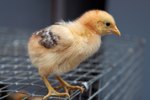
Peacocks, which are male -- females of these pheasant species are peahens -- have arguably the most ornate plumage of any birds. Far from mere embellishments, the polychromatic feathers of the two common species of peacock -- the Indian peacock of India and Pakistan and the green peacock of Java and Myanmar -- help the birds reproduce by attracting peahens, who are comparably plain in their own appearance.
Fancy Feathers
The Indian peacock and the green peacock have sapphire-colored and emerald-colored body feathers, respectively. They are best known for their elongated tail coverts, however, which in both species are metallic green in color and feature multi-hued, circular formations called ocelli. Peacocks rely on their famous feathers to "seduce" females.
Here Comes the Peacock
A peacock's elaborate plumes are part of a train of feathers that he carries behind him in a fashion often likened to the way the train of a wedding dress drags behind the bride. With an average length of 3.9 feet, the train typically represents more than half of the body length of a peacock. Indian and green peacocks sport such trains during the breeding season, from June through December. They shed their trains in January.
Displays of Affection
When courting peahens, Indian and green peacocks unfurl their trains into upright, semi-circular shapes that can be up to 7 feet wide and 3 feet tall. They are known to rattle their bodies so their iridescent feathers catch the sunlight and appear to shimmer. Peahens have several criteria for choosing which peacocks to mate with, including the vibrancy of the latter's colors, the length of their trains and the overall quality of their feathers. Successful peacocks may mate with up to six peahens during each breeding period.
Measure of Health

It's believed that the stronger the immune system of a peacock, the more ocelli he will have in his train of feathers. Healthy peacocks also spend more time showing off their trains to potential mates. Females are drawn to peacocks with more ocelli and who display for longer, presumably because their offspring stand to inherit the fathers' increased resistant to disease. Therefore, the greater the number of ocelli a peacock has, the better his chances of mating successfully.
References
Photo Credits
-
Jupiterimages/Photos.com/Getty Images
Writer Bio
Since beginning her career as a professional journalist in 2007, Nathalie Alonso has covered a myriad of topics, including arts, culture and travel, for newspapers and magazines in New York City. She holds a B.A. in American Studies from Columbia University and lives in Queens with her two cats.




